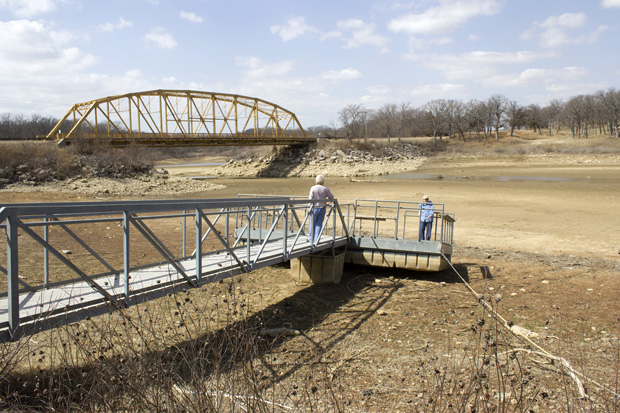
Lisa Davis (right) with the advocacy group Save Lake Texoma near the Rooster Creek Bridge at Lake Texoma State Park.
Logan Layden / StateImpact Oklahoma


Lisa Davis (right) with the advocacy group Save Lake Texoma near the Rooster Creek Bridge at Lake Texoma State Park.
Logan Layden / StateImpact Oklahoma

Logan Layden / StateImpact Oklahoma
Lisa Davis (right), founder of the advocacy group Save Lake Texoma, near Rooster Creek Bridge at Lake Texoma State Park.
At the end of August 2013, Lake Texoma was full of water. But drought, and decisions by state and federal officials have meant a drop in levels. That’s a big problem for Kingston, Okla., a community that depends on lake tourism for its local economy.
The Rooster Creek Bridge has been landmark at Lake Texoma State Park since 1940. Yellow paint covers the metal truss structure that spans the creek as it opens into Oklahoma’s second-largest lake. When the lake is this low, you can walk right under the bridge, past dusty mussel shells, and out onto piles of rock slabs set up as fish habitats.
Lake Texoma is experiencing a kind of trickle-down drought effect. The lake is fed by the Red River, which flows through areas of southwest Oklahoma and northwest Texas where the drought hasn’t stopped raging. Because of the drought, much of the water flow soaks into the dry riverbed before it reaches the Texoma reservoir.
Bob Jackman, a geologist and water consultant from Tulsa, spoke to area residents at a community meeting in hosted by the advocacy group Save Lake Texoma in Kingston last weekend.
“The problem you’re facing is you’ve got some big elephants in your Lake Texoma,” Jackman tells the crowd. “They’re big, wild ones.”
Drought is one of those elephants, Jackman says.
“Then you have — also — drainage,” Jackman says. “And that’s by Southwest Power Authority. That’s one of your villains. Also the Corps of Engineers. I have caught the Corps of Engineers in so many lies it’s just unbelievable.”

Logan Layden / StateImpact Oklahoma
Texoma area residents ask questions during a community meeting at Kingston High School March 15.
Jackman’s acrimony riled the crowd up. But no one from the Corps or Southwestern Power Administration attended the meeting to defend the continued use of the lake for hydroelectric power generation, which can lower water levels by as much as three feet per month, according to the Lake Texoma Association, which fashions itself a kind of chamber of commerce for the lake.
In a January press release, Col. Richard Pratt, commander of the Corps’ Tulsa District, says in Texoma’s significant power and water supply storage is needed the most in times of drought. Without it, the region wouldn’t have consistent water and electricity. Pratt says there are already power production limits in place, and if the drought gets worse, more will come.
The meeting attendees are also mad about an agreement between the governors of Texas and Oklahoma that lets towns in north Texas take water from Oklahoma’s side of the lake. Another issue is the promised construction of a new resort — the controversial, stalled and lawsuit-plagued Pointe Vista development — that’s supposed to take the place of Lake Texoma State Park.
“Five years ago they took our lodge away from us. It was a cornerstone of our tourist industry in this area,” one audience member says to the crowd. “They broke the contract that said one year after they were going to take that lodge away they were going to come back with a resort. We have nothing coming out of the ground and they’re not proposing anything. And it’s killing all these businesses around here. That’s what we thrived off of.”
There’s talk of lawsuits, and bills to address all these issues. None of it is certain. Residents want to help Lake Texoma, but they don’t know how. Right now, the lake is so low, the only assistance they can provide is helping the county pull tires and trash out out of the now-exposed lake bed.